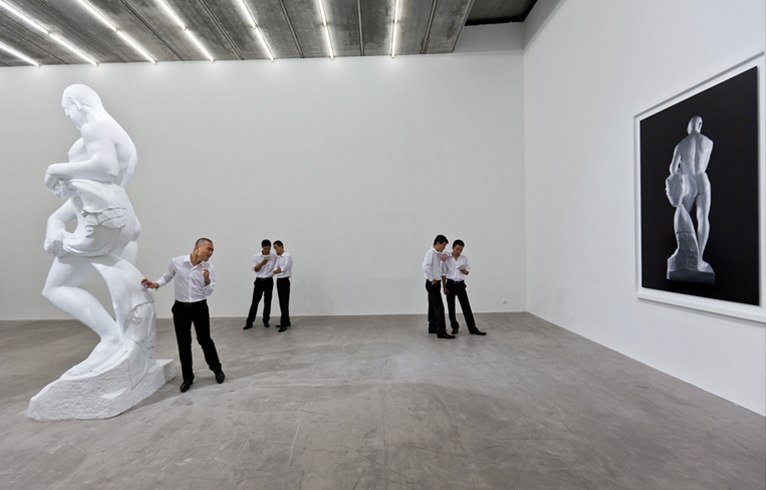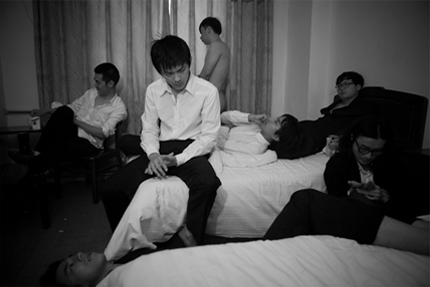YAN XING: AUTOBIOGRAPHER, VOYEUR
| December 29, 2011 | Post In LEAP 11

Yan Xing adores Hans Belting. He doubts so-called “innovation” in contemporary art. He prefers his work to be visually pure in classic black and white, and as beautiful as possible, as sharp as a knife. He might not even object to being called less an artist than a raconteur, a carefully voiced plurality of the contexts in which he exists and creates. His artistic practice, no matter the visual form it may take, tends most often to take the discursive form of great, bulging stories about his world large and small. These narratives, for all they contain, tend most often to be autobiographical, concerned with their creator’s experiences, be they sexual, familial, or art-historical. What Yan creates is most telling not as this or that installation, sculpture or performance, but instead as part of the overall narrative of his life. In other words, it could be said, the young Yan Xing has not yet created but is constantly creating, his oeuvre, one slowly expanding and blatantly revealing Künstlerroman.
Those even minimally familiar with Yan Xing’s limited output will at least know of his DADDY Project (2011), a live “performance” that saw him recount growing up with no father figure and an asphyxiating mother figure. Arguably the most exemplary of his work to date, DADDY is labeled as performance, but toss aside the video recording later projected in the gallery and what is left is nothing but a narrative of his path to adulthood, and an ambiguous one at that. The text for DADDY was initially based on a series of posts from Yan Xing’s highly personal and often scandalous blog (the banner for which has the italicized pinyin for “sun,” or slang for “to fuck,” deposited directly between Yan’s spread butt cheeks)— a sensational weaving of “Look at me!” and “Why me?” that also finds meaning embodied in Yan’s psychological, moral, and physical dealings with his surroundings, and in the implications the audience infers these dealings have had for his growth as an artist. And of course, as with any story, it finds significance in its readership, in the audience’s willingness to actually listen to and take the piece seriously.
Definitively part and parcel of finding one’s self, in the Künstlerroman or otherwise, is first finding others, or toying with voyeurism. It is not only with DADDY that Yan Xing opens himself to the audience, as several previous works turn the viewer into the illicit, peeping other. (That he beams with pride at his blog’s high PageRank and at the number of “fans” he has on Weibo is certainly worth noting, as are the tags on his blog posts: “portrait,” “life,” “affair,” “talk,” “relationship.”) Early on, Twilight of the Idols (2010) saw Yan offer his own version of the moans and groans of the female lead in the only purported pornography to star Marilyn Monroe. That the actress is actually America’s most famous sweetheart is disputed to this day— seeing her engage in such things is wrong; it tarnishes the narrative we already know. Yet fittingly, this performance was given in private, and not recorded— hearing the sounds of the fantasy wherein Yan, as Marilyn, beds a man, is certainly an affair of the most private sort: the sexual self-identification of the individual.
In another video piece, They Are Not Here (2010), voyeurism again defines the viewer’s role, and again, is turned on its head. The piece’s general situation leads the viewer to possess lascivious expectations: this infamously flamboyant artist (in DADDY, he admitted to having 124 boyfriends in one year) locks seven young men in a hotel room for more than one hour. Yet throughout the video’s entire duration, absolutely nothing happens: the men (drunk, naked, or daydreaming, they aren’t even supposed to be there, according to the title, which hangs on the room’s door outside) do not even budge once from their places. Impregnated with so much potential, the video is ultimately a work of boredom. It is the voyeur’s greatest fear. As if to further tease the viewer, too, Yan snakes about the room, squeezing between these men, camera in hand, absurdly taking picture after picture, as if taking notes for his personal diary. But after all, this is his life, his narrative; why shouldn’t he relish this freedom of practice?

All this voyeuristic manipulation is but one small sliver of a greater tendency in Yan Xing’s work: the deconstruction and reconstruction of narratives. For 2008’s Dear Letter, the narrative was his own, as he shrunk years of handwritten characters from his actual diary into microscopic size and laser-printed them line-by-line on paper; though easily attributed to prepubescent artistic timidity, the illegibility still serves to tease the viewer as much as, if not more than, They Are Not Here does. In line with his personal and artistic development, the following year’s piece Writing edged closer to bravado and transparency, as he reprinted ambiguously homoerotic letters sent to his father by a former prison-mate on plastic film. Here what shines through is not timidity, but intrepid appropriation, as he dismantled the source material and re-arranged the characters to re-imagine the meaning of the two men’s relationship. In this chapter of his oeuvre, the shadows left on the wall by this new correspondence are marks of Yan’s authorship more compelling than his actual signature below is.
Even more telling his work with the four-artist collective COMPANY, which unveils a conscious struggle with his sexuality. The video piece SEXY (2011), asked the young artists and fellow COMPANY members Chen Zhou, Li Ming, and Li Ran to play the role of voyeur-pornographer, as well. For seven minutes they document Yan Xing scrambling completely naked up the side of a mountain, repeatedly attempting to reach self-attained orgasm. The natural outdoor setting is Yan’s way of destroying the conventional narrative of voyeur as outsider-looking-in, and his failure, a means for destroying the narrative of climax-as-objective, as it leaves the both viewer and actor of this pornography physically disappointed.
In his most recent exhibition, “Realism” at Galerie Urs Meile, Yan Xing assigned a group of actors to loiter around the artist’s vision of Adonis. This took the form of a perfectly sculpted male figure, all white, stunning, and 3.5 meters tall, mirrored on the far wall by a slightly smaller portrait of the backside of the sculpture. The actors were to agree or disagree amongst themselves with selected tenets, underlined by Yan himself and accompanied by inquiries scribbled in the margins, of the ripped pages of a Chinese translation of André Breton’s Surrealist Manifesto (1924). Meanwhile, Yan himself occasionally broke out in song, belting out decades-old lyrics from the Taiwanese songstress Teresa Teng, who used to be considered indecent in Mainland China. The preferred destruction here is that of linear, art-historical narrative. Co-inhabiting the space, valences of literature, sculpture, photography, performance, popular music, politics, Classicism, Socialist Realism, Surrealism, and so on, collide with and nearly undermine one another. The intended effect of this reconstruction is dizzying, but the exhibition is at its most poignant after the performance’s completion. Repeating the previous installations People Will Die (2010) and He Has to Die (2010), Yan left the actors’ clothes in the space, crumpled on the floor along with the other material remains of the opening show. Yet just as with philosopher Arthur Danto’s idea of an end to the narrative of art history, the subject of this history is not over; the artist has merely moved on to another chapter. Each pile of Yan’s dirty laundry represents the tongue-in-cheek of a practice that doesn’t take itself too seriously, and also represents the gauzy partitions between the stages of his Künstlerroman, this autobiographical exposé of an artist’s self-development.

